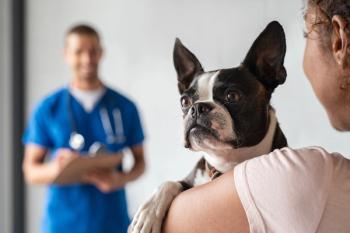
Satisfaction guaranteed?
As Karen walked into the veterinary practice's waiting room, her cat Freddie peered out of his travel crate, bobbing his head in an unrelenting search for an exit.
As Karen walked into the veterinary practice's waiting room, her cat Freddie peered out of his travel crate, bobbing his head in an unrelenting search for an exit. Karen had noticed that he was losing weight and didn't seem like himself. He was still eating everything in his food bowl, however. She was anxious for the veterinarian to see him.
The new veterinary laser surgery and medical center had made room for Freddie and told Karen to drop him off at 10 a.m. Karen was grateful but a little unsure as a girl—who appeared no older than 10—swept up Freddie's crate without a word and marched it to the back of the hospital.
"He is eating a lot," Karen started to call out, "just losing weight." Her voice trailed off as cat and young lady disappeared.
Karen approached the reception area and asked tentatively, "Can you please check on his vaccinations and check him for worms while he's here?"
The woman looked doubtfully at the door. "Well, they've already taken him to the back, but I can tell the doctor when he comes in at noon."
"Do you need me to sign something?" Karen asked.
The woman shuffled some papers and offered a crooked smile. "Naw, I don't think so, sweetie. You can come in later this
afternoon. They should have him done when you arrive."
Karen hesitated, but the receptionist never looked up again. Karen gathered up her pursue and left.
* * *
When Karen returned later that day, she heard barking and commotion in the back but saw no staff membes present. A dog seemed to scream and howl. She winced, and then sat down to wait.
A few minutes later, the receptionist appeared at the front desk. She appeared disheveled and flustered. Karen coughed to get her attention, to no avail.
After what seemed an eternity, the receptionist rose and walked Karen to an exam room without a word. Karen noticed a hint of blood on the receptionist's fingers.
"The doctor has your medications," she stated and turned on her heels.
Karen waited. And waited. As she was about to give up, a technician popped into view. "Hello, Mrs. DeFord."
"Where is Freddie?" Karen asked somewhat impatiently.
"We'll bring him out to you after you check out," the tech answered dryly. Her eyes remained fixed on the exam room computer screen. "We took several X-rays and did some blood tests, and all was normal according to the doctor."
The technician peered at the screen. Someone noted "rotten teeth," and she recommended an ultrasound and ordered an assortment of blood tests, cytology and blood cultures. There were no notations concerning the physical exam other than dental problems. There was no nindication of vaccinations or a fecal test.
"Did they test Freddie for worms" Karen queried.
"Not that I see." The tech thought for a moment and then said, "It's getting late. We'll do that next time. The doctor has recommended these procedures to find out what's wrong. Yes, that must be the case."
The technician was doing her best to decipher the doctor's notes, knowing that he had already left and wouldn't be back until tomorrow. There was another veterinarian in the office, but the two had missed each other. There was no chance they would have spoken.
Karen looked at the laundry list of recommendations and then at the total estimate: $950.
"Can I talk to the doctor about all this and about Freddie before I leave?" she asked.
"He's gone for the day," the technician said. "I can leave a note for him to call you tomorrow."
Karen was in shock. Her cat was still sick and all she had was a piece of paper.
At this point, all Karen could think about was getting her precious cat and leaving. She grabbed Freddie's pills knowing she had no idea in the world how she would get the cat to swallow them. All she knew was that she didn't want to spend any more time at the veterinary office. She paid her bill and left.
Later that evening Karen tried to Freddie a pill. She wrapped it in cheese. She tried hiding it in a cat toy. She tried slipping it between his clenched back teeth. Finally, she gave up.
Two hours passed. Freddie took a stroll to his water bowl and collapsed. He died a few minutes later.
We are failing
Not all stories end well in veterinary medicine. This one certainly did not. Each of us has an opinion and a tentative diagnosis about Freddie. One thing is for sure, we will never know whether Freddie could have been saved because the hospital failed to perform his work-up in a timely manner. As a profession, we must strive to do better.
What are the chances that Karen will ever return to this veterinary hospital? What are the chances she'll want another pet? At best, they are diminished.
This scenario is more than a story about the tragedy of a lost pet. Unfortunately, it represents issues facing hospitals across the country. In the past few years, our profession has grown more akin to human medical practice, a trend that does not bode well for client satisfaction. (See "The Satisfaction Matrix" for a comparison between physicians and veterinarians today.)
Client Satisfaction Matrix
Client satisfaction is declining
Clients of both veterinary and human medical practices are increasingly dissatisfied with the care they receive. For us, decreased satisfaction has likely led to decreased patient visits over the past few years. Why are customers less satisfied now?
Two trends have emerged in the last two decades. One is the need to demonstrate profitability as a business (beyond providing a living for an individual owner). The other is the growth of the multi-doctor business model. These trends are not inherently bad but can lead to poor practice models that decrease client satisfaction.
The pressure to improve profitability is real. The costs to deliver quality medicine are high. Practice management advisers have harped about the need for fee increases for years, but we may have reached a tipping point. When are prices too high? We may have just found out. We must keep our clients satisfied in all aspects of service delivery, including perceived fee value.
Higher prices have increased profitability but have taxed our best clients and reduced visits from the remainder. The second trend, toward multi-doctor practices, has reduced client satisfaction as well. Multi-doctor practices reduce the ability of clients to see same doctor and often create therapy conflicts if more than one doctor is involved in a patient's treatment plan.
Client satisfaction is down. Veterinary office visits are down. The scenario presented in this column offers telltale clues to the top reasons client satisfaction is declining.
Staff cuts have hurt service
Note that in the story above only one receptionist staffed the "busy" hospital, and she was doing double duty in the back. In addition, the doctors' and staff members' shifts did not overlap, resulting in plenty of miscommunication and confusion between shifts. A poor doctor-to-doctor handoff produces an atmosphere of distrust for all parties.
Did this staffing situation help this practice or Freddie? If you answered yes, you have never owned a pet.
Many practices have cut staff in order to improve cash flow during the recession. Practices are also slowing their new hiring. Cutting payroll might look good on paper, but cutting too deep can result in poor service, which loses clients and profits.
Screen time has replaced face time
Computers have invaded every room of practice, including the exam room. This has made things better and worse at the same time.
On the upside, we have on-hand access to patient records and treatment plans. On the downside, computers can decrease our ability to engage and bond with our clients. When we spend more time peering into the screen and less into our clients' eyes, we appear detached and uncaring. If you do use a computer in your exam room, take care in its placement. If you or your staff must turn your back on a client to access the computer, you lose your effectiveness as a communicator.
Professionalism is at risk
We are in a serious profession, and we need to act professionally at all times. This includes all veterinary team members and veterinarians—from the front desk to the back rooms of the practice.
Meeting people professionally means not calling anyone "sweetie" or "honey." Professionalism means smiling and interacting with clients in a caring and compassionate manner. We all get tired and cranky. If you cannot be civil, take a break and relax. We are in a helping profession. People expect us to be on the top of our game.
Experience suggests that the discharge experience is deteriorating. Clients must be happy with the discharge experience—it is the impression that lasts.
Rx for low client satisfaction
We need a treatment plan here. To describe it, I'm going to borrow from The Rolling Stones' appropriately titled hit, "Satisfaction." This tune starts with three notes, and repeats them over and over throughout the song. To reverse our client downturn—to increase their satisfaction—we need to repeat three notes of our own over and over and over:
Note #1: Communicate. You can't over-communicate with clients and staff. Improving our communication skills in the exam room and within the staff will keep clients coming back. Staff meetings are imperative.
Note #2: Staff adequately. Your staff members are your most-valuable assets. Your practice can't operate effectively without them.
Note #3: Value services appropriately. Our fees must represent the value our services bring to the patient and the client. Implement increases fairly to protect perceived fee value.
It all adds up to satisfaction—just what the doctor ordered.
Dr. Lane is a graduate of the University of Illinois and owns and manages two practices in southern Illinois. He completed a master's degree in agricultural economics in 1996. He is a speaker and author of numerous practice-management articles. He also offers a broad range of consulting services. Dr. Lane can be reached at
Newsletter
From exam room tips to practice management insights, get trusted veterinary news delivered straight to your inbox—subscribe to dvm360.






